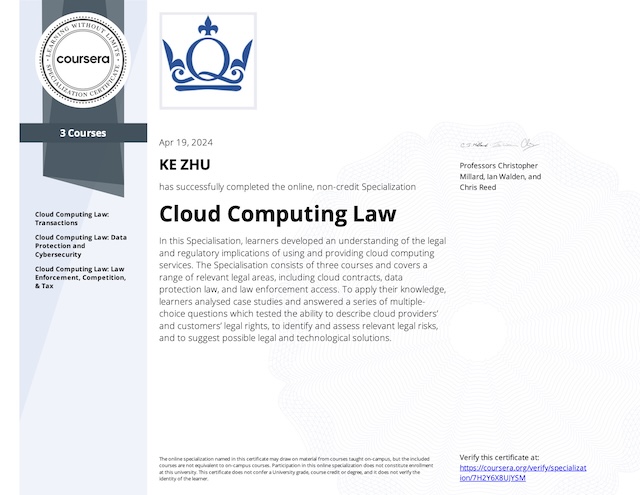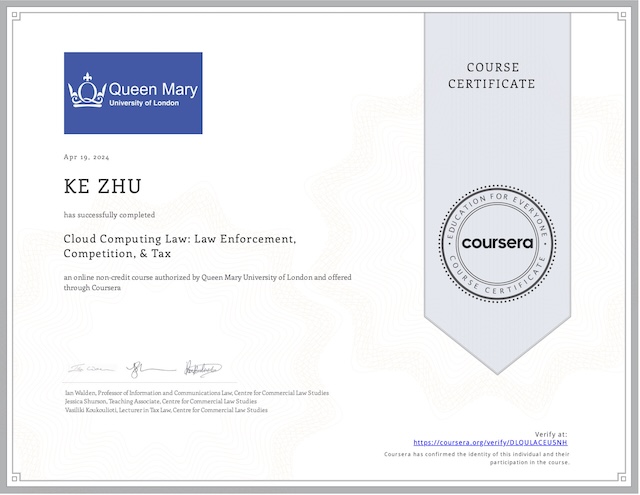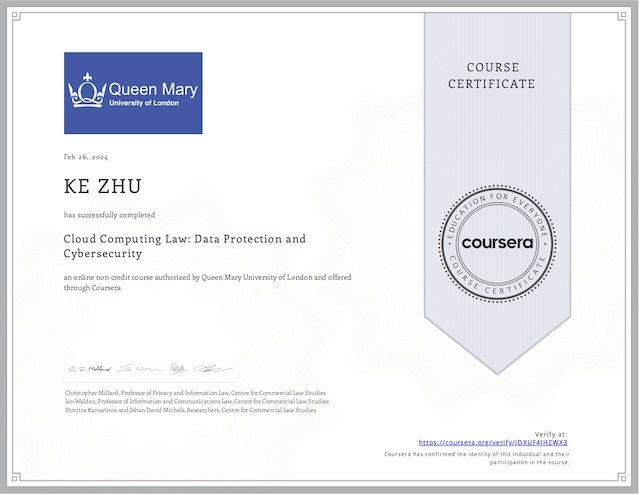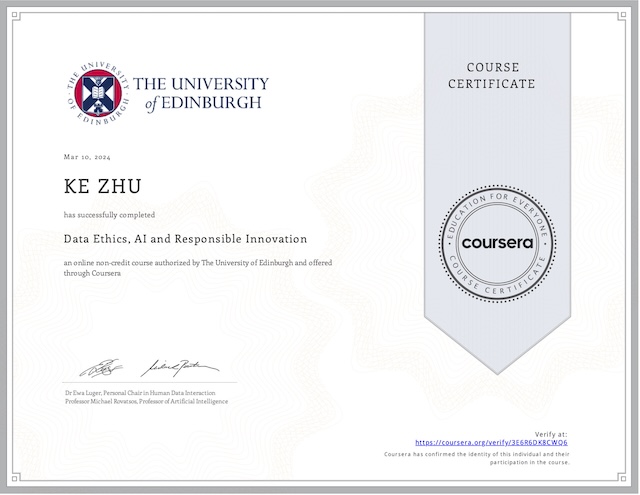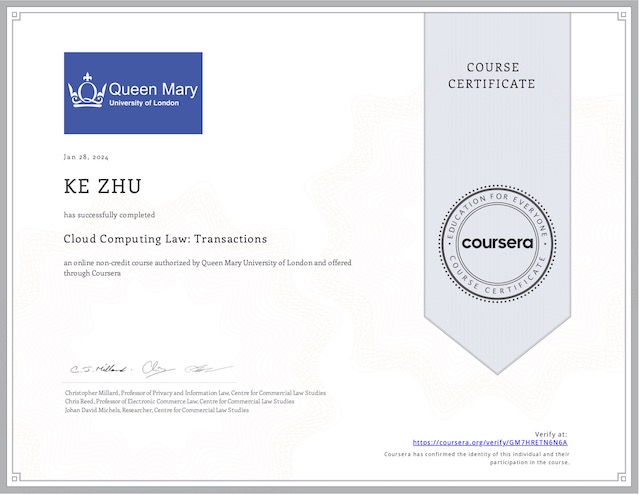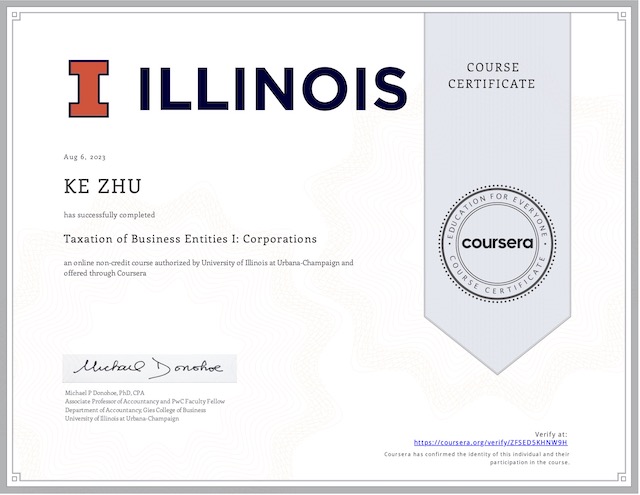Cloud Computing Law Queen Mary University of London You, as an end user of various cloud services, may find that it is quite easy to get want you want and finish your tasks on cloud services. However doing business in cloud is never easy – when you, as either providers or customers of cloud services,…
Category: Law
My 149th certificate from Coursera
Cloud Computing Law : Law Enforcement, Competition, & Tax Queen Mary University of London Often, law enforcement authorities need to access data in the cloud, which is an interesting perspective of cloud computing that users might never but should think about. Yep, big brother is watching you. The situation becomes a little bit complicated if…
My 148th certificate from Coursera
Cloud Computing Law: Data Protection and Cybersecurity Queen Mary University of London When talking about data and cloud computing, GDPR will always be on your radar. This is not something only concerns business owners and lawyers, but also affects technology and innovation. GDPR is influential, prevalent and has set a fine example to the world,…
Cloud Computing: Law Enforcement, Competition and Tax
Law Enforcement Access to Cloud Data Law enforcement authorities need to access data in the cloud. As more data is stored in or generated by our use of cloud services, law enforcement authorities increasingly need to cooperate with cloud providers to obtain this evidential data. Obtaining data that is either at rest or in transit…
My 147th certificate from Coursera
Data Ethics, AI and Responsible Innovation The University of Edinburgh How should we act in the age where artificial intelligence is fundamentally changing our lives. What is right and what is wrong? Being a tech-savvy, you probably have your own answers, but if not, this course is helping to explore the AI-enabled world and is…
Data Ethics
Shoshana Zuboff, a leading academic in the field, coined to the term ‘surveillance capitalism’, to describe the way in which human experience been transformed into behavioral data, and that data into capital or value or money. She argues that while some of this data is clearly important for service improvement, much of it is considered…
GDPR: General Data Protection Regulation
IT infrastructure and services are now regarded as a significant area of systemic risk to be managed via legal and regulatory frameworks. Most countries in the world now have data protection laws to impose obligations on organizations (controllers) which process data, and to give the data subjects (individuals whose data are being processed) specific rights…
My 144th certificate from Coursera
Cloud Computing Law: Transactions Queen Mary University of London If life is all about business, contracts are inevitable. Contracts by itself is a great topic to talk about. I have learned quite a few courses. I have to admit they some times drive my crazy. In the context of cloud computing, contracts is even more…
Introducing Cloud Computing Contracts
Nowadays, almost everyone is using cloud services in their daily lives. They are cost-effective, flexible, scalable, and allowing for specialization. The term cloud computing has been around since the late 1990s. It is defined by National Institute of Standards and Technology as: A model for enabling convenient on-demand network access to a shared pool of…
My 139th certificate from Coursera
Taxation of Business Entities I: Corporations University of Illinois at Urbana-Champaign Taxation is a very interesting perspective to observe and understand how business entities work. This course provides an introduction to the U.S. federal income taxation of corporations and their shareholders. The course is designed to cover entire lifecycle of a C corporation, from its…
Basics of Corporate Reorganization
The term reorganization is often associated with financial difficulty, such as the reorganization of debts under state or federal bankruptcy laws. For taxes purposes, however, the term refers to any corporate restructuring or rearrangement, which can, but does not necessarily occur at the end of the corporate life cycle. The US tax system aims to encourage growth….
Tax Treatment for Corporate Liquidations
Partial liquidations takes place when there is a contraction or reduction of a corporation’s business activities. Complete liquidations occur at the end of a corporation’s life cycle. Surprisingly, the IRS Code does not define what complete liquidation is. Instead, Treasury regulations indicate that a complete liquidation exists for tax purposes. … when the corporation ceases to be a…
Corporate Stock Redemption
A stock redemption occurs when a shareholder sells stock back to the issuing corporation for cash or property. A redemption raises many important and potentially complex tax issues. If the shareholder who redeem stocks is the only shareholder, a stock redemption has no effect on his proportionate ownership interest in the corporation. In this case, if this redemption…
Corporate Non-Liquidating Distribution
As corporations operate, they can share their economic successes with shareholders by making distributions. However distributions are not necessarily required and different firms have different incentives and disincentives. From a tax perspective, it is necessary to classify distribution as: The term non-liquidating distribution implies that the distributions are not in an effort to wind up the affairs of the…
Taxation for Corporation Formation: Liabilities, Capital and Loss
Along with assets, corporate formation also routinely involves the transfer and assumption of liabilities. The corporation is taking responsibilities for such liabilities, but an important tax issue arises. Does the assumption of liabilities by the corporation (transferee) constitute boot received by the shareholder (transferer)? Assumption of Liabilities Recall that in addition to the stock of corporation, shareholders can also…
